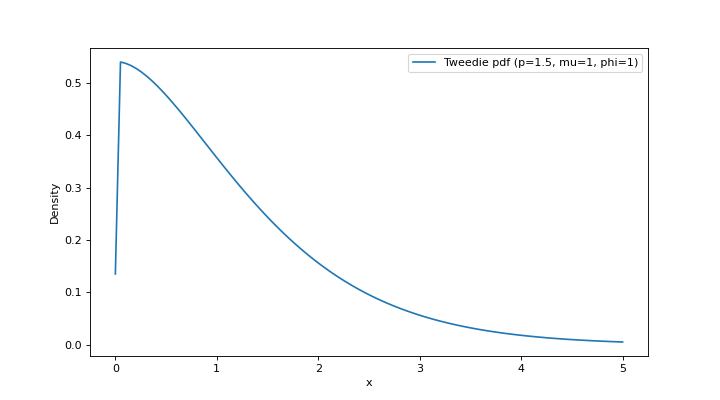tweedie#
- scikitplot._tweedie.tweedie = <scikitplot._tweedie._tweedie_dist.tweedie_gen object>[source]#
An instance of
tweedie_gen, providing Tweedie distribution functionality.This instance provides:
probability density function (pdf)
cumulative distribution function (cdf)
random sampling
for the Tweedie distribution.
The Tweedie distribution is part of the exponential dispersion family, characterized by a
pparameter that determines its behavior:p = 0: Gaussian distributionp = 1: Poisson distributionp = 2: Gamma distributionp = 3: Inverse Gaussian distribution1 < p < 2: Compound Poisson-Gamma distribution
- Parameters:
- pfloat
Tweedie power parameter.
- mufloat
Mean or location parameter.
- phifloat
Dispersion parameter, controlling the variance of the distribution.
See also
tweedie_genA Tweedie continuous random variable.
Examples
Compute the pdf and cdf at a given point:
>>> import numpy as np >>> from scikitplot.stats import tweedie >>> x = 2.0 >>> pdf_val = tweedie.pdf(x, p=1.5, mu=1, phi=1) >>> cdf_val = tweedie.cdf(x, p=1.5, mu=1, phi=1) >>> pdf_val, cdf_val
(np.float64(0.15640119832636348), np.float64(0.8519363569424107))
Generate random variates:
>>> import numpy as np >>> from scikitplot.stats import tweedie >>> rvs = tweedie.rvs(p=1.5, mu=1, phi=1, size=16) >>> rvs
array([0.36216752, 0.71189978, 0.07037264, 3.27039861, 0.28588557, 0.92038285, 0.75109561, 0.20267084, 1.26754428, 0.55384182, 2.49369275, 2.92645412, 1.47120437, 1.9703747 , 2.08446387, 1.34116342])Plot the pdf over a range:
>>> import numpy as np >>> from scikitplot.stats import tweedie >>> import matplotlib.pyplot as plt >>> x = np.linspace(0, 5, 100) >>> y = tweedie.pdf(x, p=1.5, mu=1, phi=1) >>> plt.plot(x, y, label='Tweedie pdf (p=1.5, mu=1, phi=1)') >>> plt.xlabel("x") >>> plt.ylabel("Density") >>> plt.legend() >>> plt.show()
(
Source code,png)
